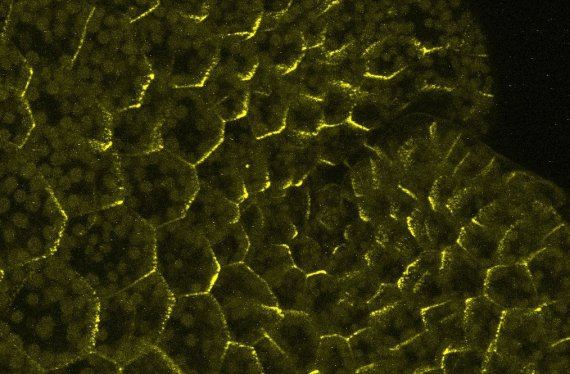An ancient protein that is involved in cell division and is crucial to growth, development, and even the prevention of cancer turns out to be almost identical in plants and animals. This has been discovered by WUR biochemists together with colleagues in Cambridge. Their findings will be published in the leading journal Cell on 30 January.
For normal cell division, the cell needs to know where its top, bottom, front, back, inside and outside is in relation to the other cells around it. ‘This is crucial to the growth and development of a plant or animal,’ says Dolf Weijers, chair at Biochemistry. ‘Otherwise a plant won’t grow any leaves, or an embryo won’t develop. And uncontrolled cell division leads to cancer.’
Mystery
Relatively, quite a lot is known about the development of this sense of direction – called cell polarity – in animal cells. But in the case of plants, it has long been shrouded in mystery. Weijers is working on solving that mystery. He had a major breakthrough last year when he and his group discovered a new set of proteins that ‘tell’ the cell what the poles of the compass are. They called them soseki or compass proteins. Soseki is Japanese for cornerstone, appropriate as the proteins are found in the corners of the cells.

At least 450 milion years old
‘We used to think cell polarity was organized differently in animals and plants,’ says Weijers. ‘Meanwhile, we have discovered that all land plants, even the oldest liverworts, use the same system with compass proteins. That makes it at least 50 million years old!’ Even more importantly, the researchers discovered that the compass proteins in plants look and behave very like a compass protein in fruit flies and humans.
Our research shows that the biochemical basis for directing cell polarity in plants and animals is the same
Dolf Weijers
They swapped around parts of the plant and animal proteins, and what happened? The proteins worked fine. ‘Multicellularity evolved in plants and animals independently of each other,’ says Weijers. ‘But it turns out there are many similarities. Our research shows that the biochemical basis for directing cell polarity in plants and animals is the same. The origin of this process can be traced back to the last common ancestor of both plants and animals. So it has not come into existence several times during the course of evolution, as we used to believe.’
Cancer research
This has important implications, says Weijers. ‘Studies on polarity in plants and animals used to be two separate worlds, but turn out to have a common denominator.’ This fundamental knowledge opens up new possibilities. ‘We always assumed that this system was unique to animal cells, but now we know that one of the proteins that plays a role in the development of cancer has a function in plants as well. That means we might be able to study certain aspects of the development of cancer, or medicines against it, in plants. But we are not that far yet.’
Follow-up
At the beginning of 2019, Weijers bagged an Advanced Grant worth 2-5 million euros from the European Research Council (ERC). He and his team are using that money to gain a fuller understanding of the way the plant compass works. ‘We know that the proteins can steer the direction in which the cell divides. Now we want to study how it all fits together. We don’t know, for example, what kind of signal is given off through the compass protein, and how exactly that translates into cell division. That is a big adventure because it is largely unexplored territory.’

 Cells of common liverwort (Marchantia polymorphade). The soseki protein which tells the cell things like which way is up and which way is down, is found in the corner of the cells. Photo: Dolf Weijers.
Cells of common liverwort (Marchantia polymorphade). The soseki protein which tells the cell things like which way is up and which way is down, is found in the corner of the cells. Photo: Dolf Weijers.